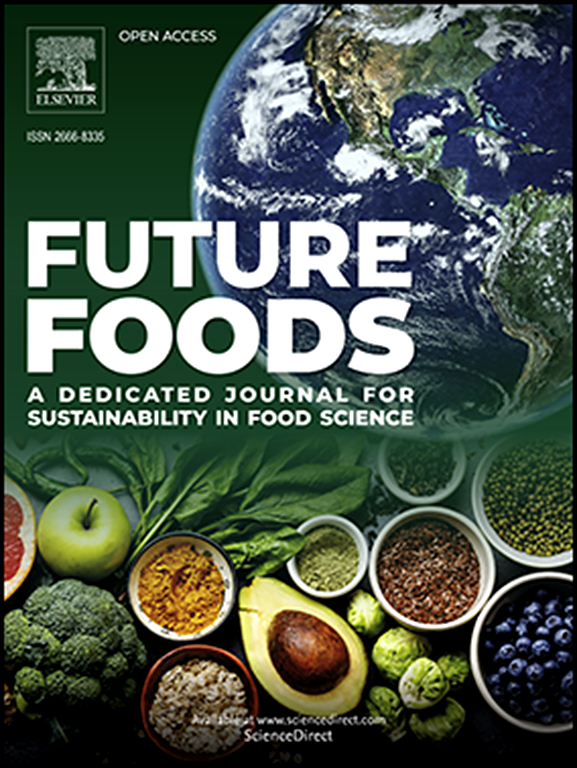含有鼠尾草提取物的聚己内酯电纺薄膜:从活性食品包装应用到假单胞菌的加速生物降解
IF 7.2
Q1 FOOD SCIENCE & TECHNOLOGY
引用次数: 0
摘要
通过电纺丝和退火工艺开发出了含有鼠尾草提取物(SE)的聚己内酯薄膜,并将其作为活性、可快速降解的食品接触材料进行了测试。首先,使用食品模拟物进行的释放测试表明,薄膜具有释放酚类物质的能力。在薄膜作为防止覆盆子品质下降的垫片的应用中,这一有益特性得到了强调。SE 含量最高的薄膜(20%)具有最高的防腐潜力,可抑制覆盆子变质、可溶性固体分解、保持色泽并增加酚含量。其次,对自然环境条件下的降解情况和加速薄膜降解的条件进行了评估。薄膜在堆肥中的完全生物降解发生在三个月内,加入铜绿假单胞菌后催化降解为四周,与 SE 的加入无关。肉眼观察、光镜、扫描电子显微镜和原子力显微镜显示,薄膜的形态决定了其表面降解机制的不均匀性。对结构特性和结晶度的分析表明,无定形和结晶薄膜区域都受到生物降解的影响。从经济和环境角度来看,所开发的薄膜作为包装材料是有益的,因为它们可以延长新鲜水果的保质期,防止产生食品垃圾,减少废弃包装材料的积累,保护环境,促进可持续发展。本文章由计算机程序翻译,如有差异,请以英文原文为准。

Polycaprolactone-based electrospun films incorporating sage extract: From active food packaging application to accelerated biodegradation by Pseudomonas
Polycaprolactone films incorporating sage extract (SE), developed by electrospinning and annealing, were tested as active, fast-degradable food contact materials. First, a release test with food simulants showed the films’ ability to release phenolics. This beneficial property was highlighted in the films’ application as pads for preventing raspberry quality deterioration. The highest SE containing film (20 %) demonstrated the highest preserving potential, suppressing raspberry spoilage, breakdown of soluble solids, maintaining color, and increasing phenolics content. Secondly, the degradation under natural environment conditions and conditions accelerating the degradation of the films was evaluated. Complete films’ bio-disintegration in compost occurred within three months, being catalyzed to four weeks by adding Pseudomonas aeruginosa, regardless of the SE incorporation. Visual appearance, light, scanning electron, and atomic force microscopy indicated an inhomogeneous surface degradation mechanism depended on the morphology of the films. Analysis of the structural properties and crystallinity showed that both amorphous and crystalline film regions were affected by biodegradation. The developed films as packaging materials can be beneficial from an economic and environmental point of view, as they can extend the shelf-life of fresh fruit, prevent the generation of food waste, reduce the accumulation of discarded packaging materials, protect the environment, and contribute to sustainable development.
求助全文
通过发布文献求助,成功后即可免费获取论文全文。
去求助
来源期刊

Future Foods
Agricultural and Biological Sciences-Food Science
CiteScore
8.60
自引率
0.00%
发文量
97
审稿时长
15 weeks
期刊介绍:
Future Foods is a specialized journal that is dedicated to tackling the challenges posed by climate change and the need for sustainability in the realm of food production. The journal recognizes the imperative to transform current food manufacturing and consumption practices to meet the dietary needs of a burgeoning global population while simultaneously curbing environmental degradation.
The mission of Future Foods is to disseminate research that aligns with the goal of fostering the development of innovative technologies and alternative food sources to establish more sustainable food systems. The journal is committed to publishing high-quality, peer-reviewed articles that contribute to the advancement of sustainable food practices.
Abstracting and indexing:
Scopus
Directory of Open Access Journals (DOAJ)
Emerging Sources Citation Index (ESCI)
SCImago Journal Rank (SJR)
SNIP
 求助内容:
求助内容: 应助结果提醒方式:
应助结果提醒方式:


